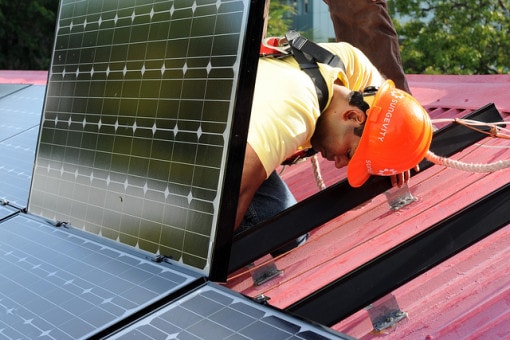This article is based on research conducted on some of the most innovative thinkers and practitioners where building and sustaining environmentally friendly houses are concerned. The list below is extensive and deliberately random. But as you peruse it, you will clearly be able to identify some correlations.
The motivation for being random with our choices is to allow you to be inspired, innovative and creative with your own set of circumstances. Realistically speaking, not everyone can just simply pack up and go, but, as the list clearly shows, you can still make paradigm shifts in the direction of an eco-friendly home which will not only protect your environment but sustain you and your family well into the future.
When building a new eco-friendly or environmentally-friendly home, you need to make sure that the new home is sustainable, saves you money as well as preserve the environment. Use the suggestions below to make sure you are building an environment-friendly home.
1. Begin by buying your own land: This gives you a unique opportunity to basically start from scratch and build your first eco-friendly home. It will be a lot cheaper than mortgage prices for existing structures.
2. But first choose your location carefully: This is of primary importance. The location of your plot must be aligned strategically with the direction of the sun’s path. It will help you to streamline your energy use in the future.
3. Educate and empower yourself: No-one is suggesting that you enroll for an architectural degree or diploma, but this wouldn’t be a bad idea anyway. In any case, information is widely available from a variety of media sources to educate you on new eco-friendly building and home maintenance technologies.
4. Then focus on keeping things small: The smaller your living space, the greater the potential to make energy savings. Having space that you aren’t using is also wasteful.
5. The truly independent homestead: This is an all-encompassing motivation. Alternative energy sources such as solar and wind power are not yet all connected to an expensive national grid. But it is possible now to apply your mind to domestic installations which are widely available. Not only is it a cost-saver, you never have to submit another bill to your local supplier anyway.
6. Everything gets re-used: It takes time to adopt this practice. Simply apply your mind as you would to making savings to your bank and investment accounts. By adopting a re-use practice, you drastically reduce the need to waste expenditure on new items.
7. Isolate and insulate: You may need readily available technical assistance for this strategy. What it basically entails is detecting and isolating air leaks which are normally found around ducts, doors and windows. And these leaks, unseen, contribute to additional amounts of energy being expended on either warming or cooling your home.
8. Solar power: No matter what type of eco-friendly structure you will be erecting in the future or how your existing house is built, installing solar panels is possible and should be high on your list of priorities. It’s an effective form of energy use and storage and will drastically reduce or eliminate what you would have normally spent on sourcing power.
9. Energy efficient windows: Make a note of this legend. It’s called Energy Star Windows. And it includes a ratings system commensurate with the amount of energy you will be using and/or saving. In this case, the lower the rating, the more efficient the window is. It also eliminates the added energy expenditure proportionally per (normal) window.
10. More info on windows: Choose double-glazed windows (over single-glazed) and wood-framed windows, and you will be amazed at how much you will conserve and save on these previously overlooked appendages from our perceptively modern lifestyles.
11. Environmentally-friendly lighting 101: It’s a simple trick which takes up no time or money. Simply replace old bulbs with energy-saving (fluorescent) light bulbs. LED lighting is also an option. In all cases, these lighting features last longer, use less power and save you more money exponentially.
12. And what about geothermal energy?: When making your house as energy efficient and self-reliant as possible, you need to consider all available options and prime yourself towards adding more than one environmentally-friendly source of power. Geothermal energy is one such option. It routes power from the earth via an earth loop and directly into your existing HVAC system.
13. Think seriously about community orientation: The old adage about sharing is that it is caring. Creating closely-knit neighborhoods opens the window towards sharing power and other innovative recycling depots strategically placed near everyone’s homes.
14. And there’s no such thing as trailer trash: Forget about the prejudice previously associated with poor Americans who had no alternative before. New, fresh and innovative thinkers have been adapting these otherwise mobile contraptions for consummate and stylish green-living.
15. You could even become a hobbit: One American family will be bedding down tonight in their own, self-styled Hobbit-like home, otherwise christened as The Dome. In essence, this dome-like structure has been sourced entirely from natural and local materials. You could use this real-life story as a source for your own future inspiration.
16. Or live in a recyclable cabin: This too, is possible. One writer created his own cabin, sourcing entirely organic materials. But this home’s feature is its self-sufficiency through the utilization of off the grid energy and water gathering sources.
17. Sustainable building material tricks: You need to go back in time and examine the way our forefathers used to live. Back then, everything, whether wood or clay was sourced entirely from nature and also effectively insulated homes naturally.
18. Micro and multifunctional living spaces: If you are still confined to urban living spaces, you can still make an eco-friendly contribution by choosing appropriately sized and structured apartments designed for multiple use.
19. Only use sustainable and re-usable building materials: This is simply a rule of thumb and easy to implement because everything, from glass to wood to locally produced bricks, is readily available.
20. Source from and support your local suppliers: Extending the previous motivation, bypassing large, mainstream manufacturers and retailers also helps you to reduce carbon footprints further.
21. Collect rainwater: Conservation collection points can be strategically built around the home to harvest natural water.
22. Then save it: The exercise is extended by using storage units to save unneeded water for later use.
23. How you can use water efficiently: Even in conventional homes, this is now possible. Fixtures and fittings such as faucets and shower heads are now widely available.
24. The HVAC system: As a technologically advanced system, Energy Star rated, it remains a sophisticated comfort zone which also saves energy exponentially.
25. How you can control and reduce your heating and cooling MOs: But even without the HVAC, there are practical ways to insulate your home at no cost. For instance, you can close your curtains when leaving the home. This captures and stores either warm or cool air for when it is needed.
26. Below the decks options: As mentioned earlier, geothermal energy sourcing via an earth loop directs heat to your HVAC system, if used.
27. Ceiling insulation: Insulating lofts poses no challenges, is cost effective and now uses recyclable materials.
28. Aligning landscaping with nature: This point is aligned with an earlier point on choosing your location.
29. All your furniture from recycling: This is an easy to follow rule because furniture made from recycled materials is widely available and becoming a market captive practice.
30. Eco-friendly and attractive painting: Go for low VOC. Traditional paints contain damaging volatile organic compounds (VOCs). Paints from manufacturers like Benjamin Moore (Muslin [OC-12]) contain fewer atmosphere- polluting volatile organic compounds.
31. Consider buying old furniture: Websites such as Craigslist and Freecycle offers you an option to buy used furniture using old furniture instead of buying new one can save environment.
32. Run ceiling fan: If it is not too hot inside your home, consider running ceiling fan instead of an air conditioner. Use them whenever possible to keep home cool in the summer. Reducing the usage of air conditioners can result in significant cost savings for your family.
33. Home energy audit: You can perform home energy audit on your own, or you can hire someone to come in and perform a more professional approach. No matter which route you take with a home energy audit, you’ll be able to find room to save energy and money and help reduce your carbon footprint.
34. Dual-flush toilet: The dual-flush toilet offers two flush options, one for liquid waste (usually 0.8 gallons per flush) and one for solid waste (1.6 gallons per flush). Your family could save up to 80% on your toilet water consumption.
35. Install a skylight: A skylight can add natural beauty to your home while reducing your energy consumption with daylighting and ventilation. When properly selected and installed, skylights can help minimize your heating, cooling, and lighting costs. It is important to consider your home position in order to maximize the benefits.
36. Compost kitchen scraps: There are many items that we throw out from the kitchen on daily basis. Instead, these items like fruit and vegetable peels, eggshells can be recycled to produce compost which can be fruitful for your garden. If not used for composting, these items will end up in landfills. So, this actually helps to reduce the amount of waste in landfills.
37. Programmable thermostat: A programmable thermostat can help you save money in heating and cooling costs. For example, a programmable thermostat old keep your home warmer when you’re out during the day and would turn it on when you get home.
38. Motion sensor lights: These lights, as their names suggest, can sense when someone or something is coming in or out of a room, so that you don’t have to worry about “turning off the lights” when you leave the room.
39. Solar powered outdoor lights: If you live in an area that gets a lot of sunlight during the day, then solar powered outdoor lamps could help you reduce your energy consumption and still have lights on.
40. Sufficient windows in each room: While building your home, make sure you have sufficient windows in each room. Let sunlight come in through these windows and you can use it throughout the day. Windows even bring in breezes even the warmest day and help you save money on heating and cooling costs.
41. Plant trees: Trees around your home will provide you with fresh air throughout the day. Apart form that, trees provide shade that keeps the house cool.
So, now you can see that there are numerous innovative and cost-saving initiatives included in this check-list styled building plan for your green future. And while you may not be ready to move or build just yet, you can still implement changes around your home as early as today.
We hope you had as much fun going through this list as we had in putting it together. We also hope that you now agree that this is the way of the future. It is essential for ensuring our survival as well as that of our entire natural environment. Rewardingly, it entails a return to basics and immersing ourselves in nature, just as Mother Nature originally intended.







